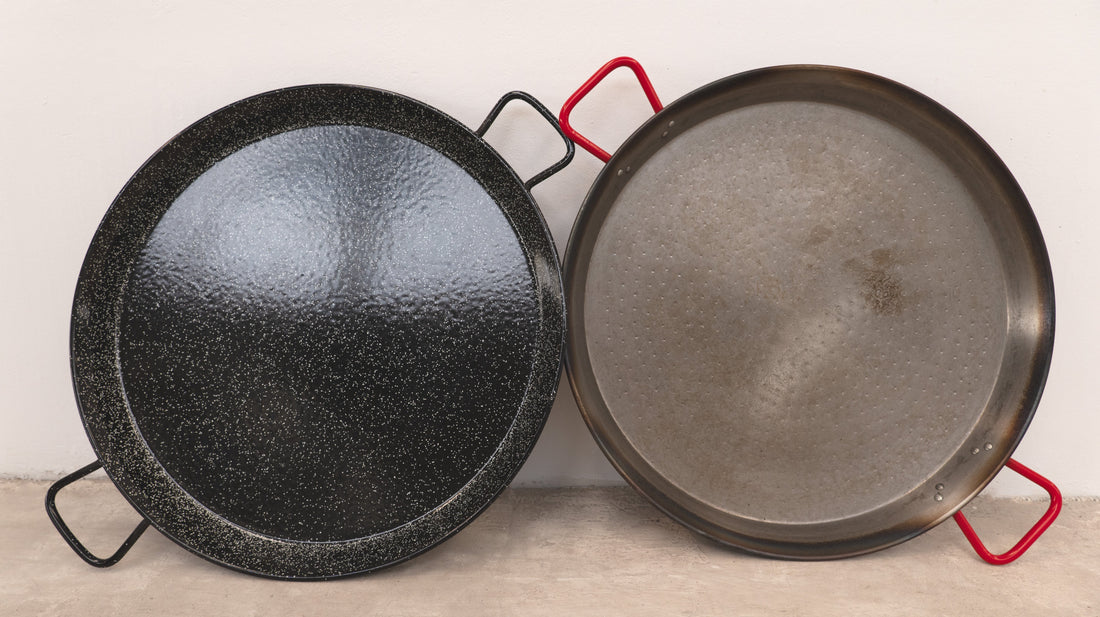
The perfect paella: material, size and proportion
Just as important as the gas stove is the choice of the paella pan (the pan where the rice is cooked).
The material of the paella
The material from which the paella pan is made directly influences the cooking process, flavor, and durability of the utensil.
Polished or glazed?
 The Polished steel paella pans are the most traditional and have been used for generations throughout the Mediterranean basin. Their main advantage is their excellent heat conduction , which allows for quick and even cooking of the rice. However, they require certain care: as they are prone to rust, it is essential to dry them thoroughly after each use and apply a light layer of oil to protect them.
The Polished steel paella pans are the most traditional and have been used for generations throughout the Mediterranean basin. Their main advantage is their excellent heat conduction , which allows for quick and even cooking of the rice. However, they require certain care: as they are prone to rust, it is essential to dry them thoroughly after each use and apply a light layer of oil to protect them.

On the other hand, enameled steel paella pans have gained popularity for their durability and ease of maintenance. The enamel coating prevents rust, making them perfect for frequent and prolonged use. They don't require seasoning and are easier to clean, although you should avoid sharp knocks that could damage the enamel. A cross between tradition and practicality, these paella pans offer a reliable and long-lasting experience.

José Zafra, a paella enthusiast, claims that enameled steel has a longer lifespan than unenamelled steel paella pans, as the former does not rust and, consequently, does not degrade. However, it should be noted that the material (enamel) will lose its non-stick properties with use, a fact that occurs with all similar products. Even so, the enameled steel pans last longer than polished paella pans.

At the more robust end, we find cast iron paella pans . They are heavier and require more time to heat, but their heat retention capacity is exceptional. This allows for highly controlled cooking, ideal for rice dishes that require standing or are served directly at the table. However, their maintenance is more demanding: they must be seasoned before first use and kept well-oiled to prevent rust.
In all cases, paella care is key. What many call " curing "—that initial treatment that protects the surface—and proper cleaning after each use not only prolong the utensil's lifespan but also improve the flavor of each rice dish over time.
The thickness of the paella
The thickness of a paella pan is a detail that, although often overlooked, has a direct impact on the final result. A paella pan that is too thin , the kind usually found in budget versions or basic kits, tends to warp easily under intense heat . This causes the bottom to not remain flat and the oil or broth to move to the edges, creating uneven cooking areas. The rice left in the center may end up drier, while the rice around the edges could be tough or undercooked.
For this reason, cooks who value precision when cooking rice often opt for medium- or thick-walled paella pans , which guarantee greater structural stability even at high temperatures. This type of paella pan maintains a uniform surface throughout the cooking process, promoting even heat distribution from the stovetop or gas paella pan . This is especially important at key moments, such as the initial sealing of the sofrito or the point at which the broth begins to reduce and the rice must absorb the flavors without thermal shocks.
Additionally, thicker paella pans have greater thermal inertia , meaning they retain heat more consistently, facilitating finer control of the heat, especially outdoors. This type of cookware responds better to temperature adjustments, allowing you to play with cooking times and find that ideal balance between loose grain and perfect socarrat. Ultimately, investing in a paella pan with the right thickness isn't a whim: it's a technical decision that makes the difference between a good rice dish and a truly memorable one.
The size of the paella
Choosing the right size paella pan is, without a doubt, one of the most important decisions when cooking good rice. Although this aspect is often underestimated, the truth is that the surface area and distribution of the rice in the pan directly influences the texture, flavor, and balance between broth and evaporation. A paella pan that's too small for the amount of rice you want to prepare tends to concentrate the grain excessively , making it difficult to cook evenly. Under these conditions, the rice can cook unevenly, become lumpy, or even mushy, losing that sought-after loose, syrupy texture. Conversely, a paella pan that's too large for the amount of rice used can have the opposite effect: heat is dispersed, the broth evaporates too quickly, and the rice doesn't have enough time to absorb all the flavors. The result is often dry, hard, and poorly bound rice.
In recent years, a modern trend has become popular that advocates very thin rice, practically a single layer that doesn't quite cover the entire base of the paella. This technique achieves a subtle and uniform socarrat , and results in rice with a more concentrated flavor, with a firmer, caramelized texture at the base. Visually appealing, and well executed, delicious. However, it requires absolute precision in heat and time control: the broth evaporates very quickly, and a few seconds can make the difference between loose rice and dry or overcooked rice. This is where the importance of a good gas stove or gas paella pan comes into play , allowing precise power regulation and maintaining a stable flame from start to finish.
On the other hand, traditional paellas , especially in the Valencian Community, typically have rice between 1 and 2 centimeters deep in the pan. This more classic style allows for a more relaxed and even cooking, as the volume of rice retains heat differently, and the broth takes longer to fully reduce. Cooking this type of paella also requires control, but offers more room for small variations without compromising the final texture.
Either style—modern and sleek or traditional and taller—is both valid and delicious when executed well, but the key is matching the paella pan’s size to the number of diners and the desired cooking style . You can’t use the same pan to cook rice for two as for eight. In that sense, having a versatile gas burner like SIDONNIS , which can adapt to paellas up to 70 cm and deliver even heat, allows you to experiment with different sizes and styles without sacrificing control or precision. Because, in the end, cooking great rice starts with respecting proportions and understanding that every choice—including the size of the paella pan—completely changes the final experience on the plate .
In the art of cooking good rice, every detail counts. The choice of material, thickness, and size of the paella pan are decisions that make the difference between a perfect dish and an unforgettable experience. And since every good chef needs the best tools, having a gas stove or a gas paella pan like those from SIDONNIS is essential to achieving that perfect balance between flavor, texture, and tradition. Because it's not just about cooking, but about creating moments around the fire. And there, where warmth becomes a memory, the true magic begins.


